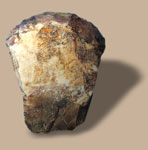|
|
|
The Debert Palaeo-Indian National Historic SiteThe Debert Palaeo-Indian National Historic Site of Canada is, today, the oldest known and best-recorded Palaeo-Indian site in Atlantic Canada. It gives evidence of the earliest human occupation in eastern North America dating to 10,500-11,000 years ago. Discovered unexpectedly in 1948 by a couple who were berry picking, the site is located near Debert, Nova Scotia. Field research was undertaken there by the National Museum of Canada in 1963-64. Living in a northern forest/tundra environment that followed the last ice age, these early Maritimers relied on migrating herds of caribou for their survival. What archaeologists have found at Debert is only a small fraction of their material culture. What remain are stone tools, projectile points, and stone-working debris. Those found at Debert, and similarly at other Palaeo-Indian sites across North and South America, are very distinctive and indicate considerable skill in selecting and working stone to produce a sharp and durable working edge. Hard, colorful volcanic rock was quarried as far as 50 kilometres from the site. Of special note are the 'fluted' hunting blades and other tools. These fluted tools enabled the fastening of the handle or spear shaft. Other characteristic tool types include awls, drills, gravers and spokeshaves - all used in shaping and probably decorating materials such as wood, bone, ivory and antler. A selection of more than 300 tools and weapons made by the ancient hunters at Debert is presented here. |
Bibliography · Links · Credits · Index


